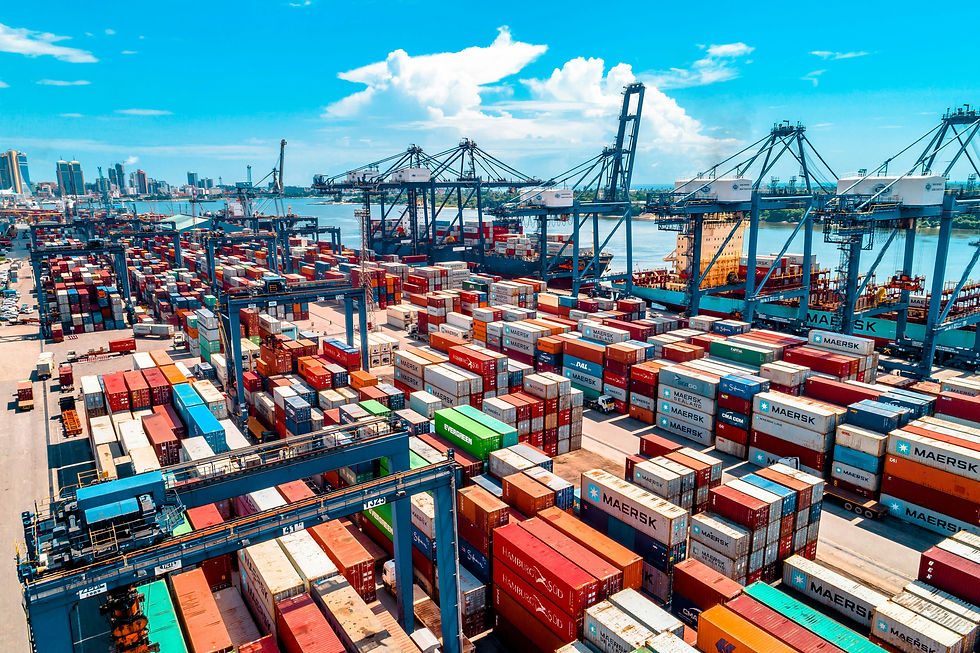The Most Commonly Used Shipping Containers: What a Shipper Needs to Know
- Sean Menezes

- Aug 14
- 3 min read
When it comes to global trade, shipping containers are the silent workhorses keeping goods safe, organized, and moving efficiently. Whether you’re shipping machinery across oceans, fresh produce to a neighboring country, or personal effects overseas, choosing the right container can mean the difference between a smooth delivery and a costly headache.
In this guide, we’ll break down the most commonly used shipping containers, their dimensions, typical uses, and key considerations — so you can make informed decisions every time you ship.

1. Standard Dry Containers (General Purpose)
Sizes:
20ft (Dry Van) – External: 20’ x 8’ x 8’6” (L x W x H)
40ft (Dry Van) – External: 40’ x 8’ x 8’6”
40ft High Cube – External: 40’ x 8’ x 9’6” (extra height)
Best For:
Consumer goods
Clothing and textiles
Electronics
Packaged foods (non-perishable)
Key Advantages:
Most widely available
Cost-effective option for general cargo
High cube versions offer extra cubic capacity without much added cost
Shipper Tip: High cube containers are perfect for light but bulky cargo — you can fit more in vertically without exceeding weight limits.

2. Refrigerated Containers (Reefers)
Sizes: 20ft and 40ft (both standard and high cube versions available)
Best For:
Fresh produce, dairy, meat, seafood
Pharmaceuticals
Chemicals sensitive to temperature
Features:
Integrated refrigeration units
Temperature control from approx. -30°C to +30°C
Power supply via ship or shore connection
Shipper Tip: Book reefers early during peak produce seasons — capacity is often tight. Also, pre-cool your cargo before loading; reefers maintain temperature, not lower it.
3. Open Top Containers
Sizes: 20ft and 40ft
Best For:
Machinery
Large equipment
Over-height cargo that won’t fit through standard container doors
Features:
No rigid roof — uses a removable tarpaulin
Allows loading from above with a crane
End doors for easy side access
Shipper Tip: Always account for weather exposure during transit; use proper covering and packing for sensitive goods.
4. Flat Rack Containers
Sizes: 20ft and 40ft
Best For:
Heavy machinery
Vehicles
Building materials
Oversized industrial equipment
Features:
Collapsible or fixed ends
No side walls or roof
Allows loading from the sides or top
Shipper Tip: Lashing and securing cargo is critical — budget extra time for proper securing to avoid shifting damage in transit.
5. Tank Containers (ISO Tanks)
Size: Standard 20ft frame (holds approx. 24,000 liters)
Best For:
Bulk liquids (edible and non-edible)
Chemicals and hazardous liquids
Wine, oils, juices
Features:
Built to ISO standards for intermodal transport
Stainless steel tanks with protective frame
Fully sealed and pressurized if required
Shipper Tip: Always confirm tank cleanliness certification before loading food-grade cargo — many tank operators provide cleaning certificates.
6. Specialized Containers
Beyond the main categories above, specialized options include:
Double Door Containers – Easier loading/unloading from both ends
Side-Opening Containers – Full-length access for long cargo
Ventilated Containers – Ideal for organic cargo like coffee or cocoa beans
Insulated Containers – Passive temperature control without active refrigeration

Choosing the Right Container: Key Considerations
When selecting a container, shippers should evaluate:
Cargo Type & Sensitivity – Perishable, oversized, or hazardous goods require special handling.
Weight & Volume – Calculate both. Will your cargo fit, and will it exceed the container's weight limit? Could you benefit from a high cube?
Route & Handling – Will it need to be loaded by a crane? Does the destination have the equipment to handle a specialized container?
Budget & Availability – Some containers carry premium rates, especially in peak seasons.
Final Thoughts
The right shipping container can protect your cargo, optimize your costs, and ensure compliance with international shipping regulations. By understanding the strengths and limitations of each type, you’ll be better prepared to make decisions that keep your supply chain running efficiently.
If you need expert advice or help securing the right container for your next shipment, our team can provide tailored solutions to match your cargo and route.



